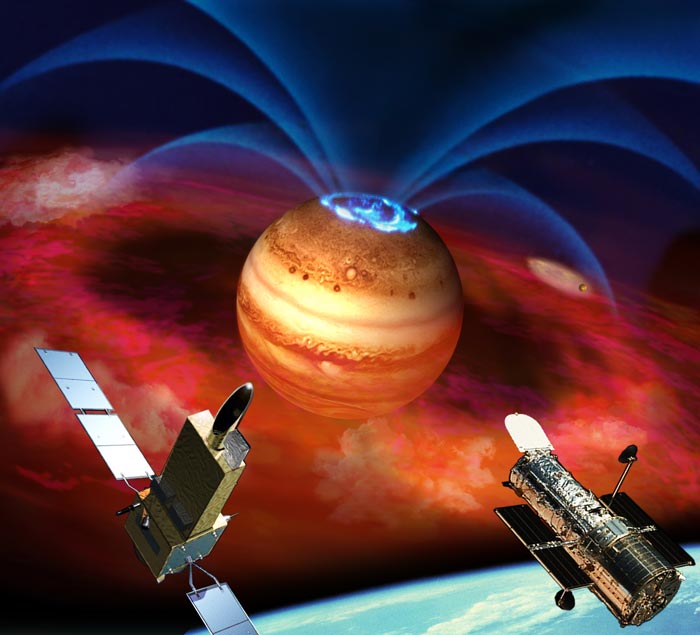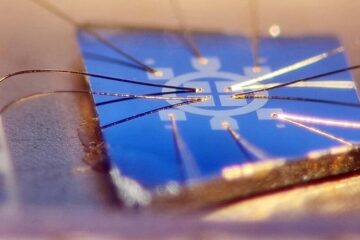Explosions of Jupiter’s aurora linked to extraordinary planet-moon interaction

In this artist’s rendering, flows of electrically charged ions and electrons accelerate along Jupiter’s magnetic field lines (fountain-like blue curves), triggering auroras (blue rings) at the planet’s pole. Accelerated particles come from clouds of material (red) spewed from volcanoes on Jupiter’s moon Io (small orb to right). Recent observations of extreme ultraviolet emissions from Jupiter by satellite Hisaki (left foreground) and the Hubble Space Telescope (right) show episodes of sudden brightening of the planet’s auroras. Interactions with the excited particles from Io likely also fuel these auroral explosions, new research shows, not interactions with particles from the Sun. Credit: Japan Aerospace Exploration Agency
Jupiter watchers have long known that the giant planet’s ever-present polar auroras – thousands of times brighter and many times bigger than Earth – are powered by both electrically charged particles from the Sun colliding with Jupiter’s magnetic field and a separate interaction between Jupiter and one of its many moons, called Io.
But there are also auroral explosions on Jupiter, or periods of dazzling brightening, similar to auroral storms on Earth, that no one could definitively trace back to either of those known causes.
In the aurora-making interaction of Jupiter and Io, volcanoes on the small moon blast clouds of electrically charged atoms (ions) and electrons into a region surrounding Jupiter that’s permeated by the planet’s powerful magnetic field, thousands of times stronger than Earth’s.
Rotating along with its rapidly spinning planet, the magnetic field drags the material from Io around with it, causing strong electric fields at Jupiter’s poles. The acceleration of the ions and electrons produce intense auroras that shine in almost all parts of the electromagnetic spectrum but most brightly in high-energy bands, like ultraviolet light and X-rays, that are invisible to unaided human eyes.
Now, new observations of the planet’s extreme ultraviolet emissions show that bright explosions of Jupiter’s aurora likely also get kicked off by the planet-moon interaction, not by solar activity.
A new scientific paper about these observations by Tomoki Kimura of the Japan Aerospace Exploration Agency (JAXA), in Sagamihara, Kanagawa, Japan, and his colleagues, was published online today in Geophysical Research Letters, a journal of the American Geophysical Union.
Starting in January 2014, a telescope aboard the JAXA’s Hisaki satellite, which focused on Jupiter for two months, recorded intermittent brightening of the giant planet’s aurora. The telescope detected sudden flare-ups on days when the usual flow of charged particles from the Sun, known as the solar wind, was relatively weak.
Additional space and ground-based telescopes, including the Hubble Space Telescope, also viewed Jupiter during these lulls in the solar wind. Both Hisaki and Hubble witnessed explosions of the planet’s aurora despite the solar wind’s calm, suggesting that it’s the Jupiter-Io interaction driving these explosions, not charged particles from the Sun, according to the new study. The new research does not address exactly what is happening in the Jovian magnetosphere to cause the temporary brightening of auroral explosions.
###
The American Geophysical Union is dedicated to advancing the Earth and space sciences for the benefit of humanity through its scholarly publications, conferences, and outreach programs. AGU is a not-for-profit, professional, scientific organization representing more than 60,000 members in 139 countries. Join the conversation onFacebook, Twitter, YouTube, and our other social media channels.
AGU Contact:
Nanci Bompey
+1 (202) 777-7524
nbompey@agu.org
JAXA Contact:
Chisato Ikuta
+81-42-759-8008
ikuta.chisato@jaxa.jp
Media Contact
All latest news from the category: Earth Sciences
Earth Sciences (also referred to as Geosciences), which deals with basic issues surrounding our planet, plays a vital role in the area of energy and raw materials supply.
Earth Sciences comprises subjects such as geology, geography, geological informatics, paleontology, mineralogy, petrography, crystallography, geophysics, geodesy, glaciology, cartography, photogrammetry, meteorology and seismology, early-warning systems, earthquake research and polar research.
Newest articles

Boron deficiency: oilseed rape reacts as with infection and pest infestation
Genetic mechanisms uncovered… Boron deficiency has a devastating effect on oilseed rape and related plants. However, little is known about the underlying genetic mechanisms. A study shows that the response…

Quantum Precision: A New Kind of Resistor
Researchers at the University of Würzburg have developed a method that can improve the performance of quantum resistance standards. It´s based on a quantum phenomenon called Quantum Anomalous Hall effect….

Security vulnerability in browser interface
… allows computer access via graphics card. Researchers at Graz University of Technology were successful with three different side-channel attacks on graphics cards via the WebGPU browser interface. The attacks…




















